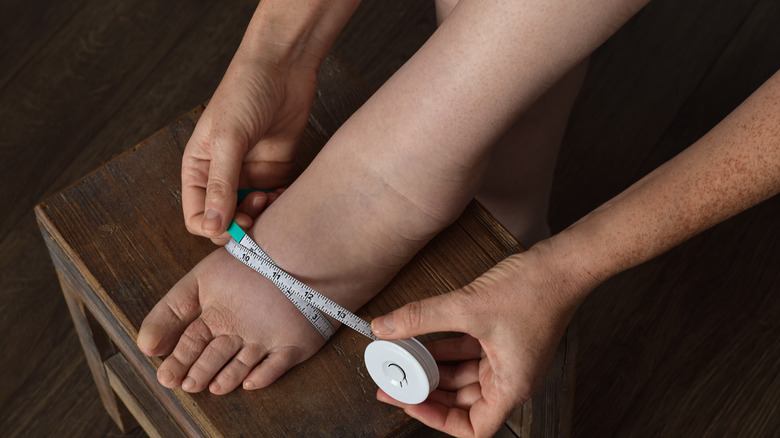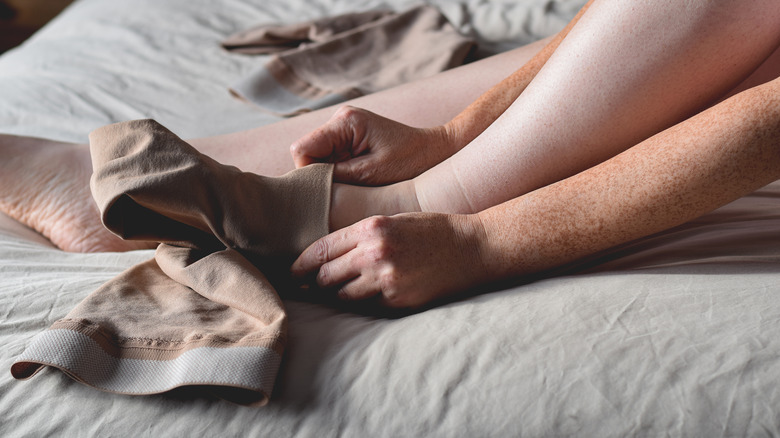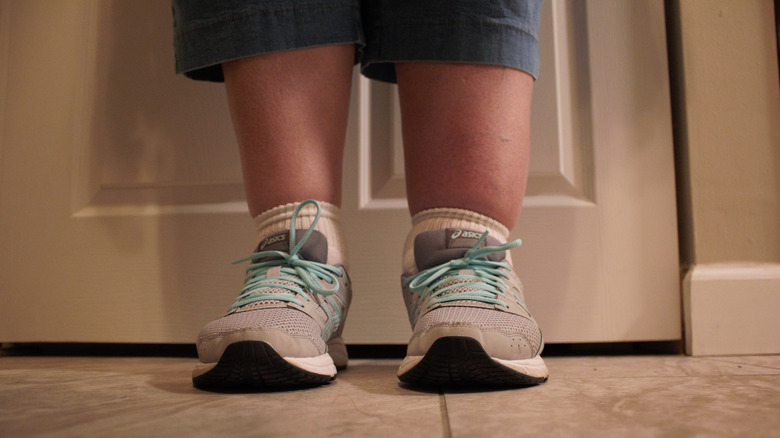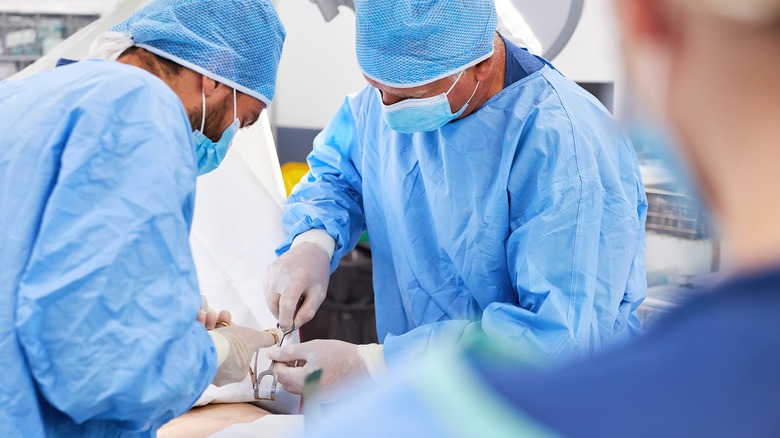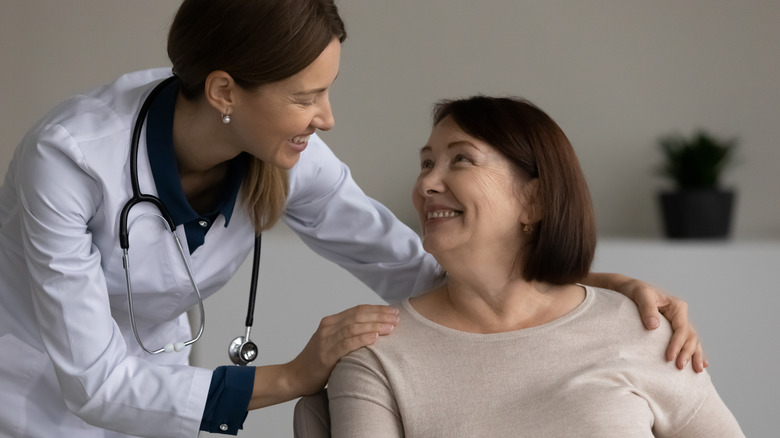How To Live With The Symptoms Of Lymphedema
A healthy lymphatic system is important for maintaining a well-functioning immune system (via Cleveland Clinic). But if it's not working properly, you may develop a condition called lymphedema, which can be challenging to live with.
The lymphatic system is a network of tissues, vessels, and organs that all work together to move lymph, which is excess fluid from the body's plasma that seeps into the tissues. The lymphatic system collects this fluid and moves it from the tissues back into the bloodstream. It helps to keep fluid levels stable, absorb digestive tract fats, keep bacteria and viruses out, and remove waste. When it's not running smoothly, you're more at risk for infections, inflammation, and more.
One condition of the lymphatic system, lymphedema, happens when the protein-rich lymph fluid isn't drained from the lymph vessels properly (via Mayo Clinic). This accumulation of fluid causes the tissues to swell, usually in the arms and legs but also in the chest wall, abdomen, neck, or genitals. It's caused by anything that blocks the lymph fluid from draining, such as cancer, radiation cancer treatment, surgery, or parasites.
Symptoms of lymphedema
Knowing the signs of lymphedema can be important for recognizing it as soon as possible and getting proper treatment, according to the American Cancer Society. Symptoms can include swelling in the hands, breasts, shoulder, arms, legs, fingers, toes, or other parts of the body. Your skin may feel tight or hard, and you might notice it changing texture or color. The area could feel full or heavy, with aching, tingling, numbness, or other discomfort. You might not be able to move certain joints as easily as you once did, such as your wrists or shoulders. Additionally, you might notice it's more difficult to fit your arm into a sleeve or button your pants, and jewelry may feel tighter — even if you haven't gained weight.
While it's most common to experience lymphedema in the arms and legs, it may also affect the breasts, chest, and underarms if it developed after breast cancer treatment. If you received treatment for cancer in the abdomen or pelvic area, lymphedema might affect your abdomen, genitals, or legs. It's also possible to develop lymphedema in the face and neck area if you were treated for cancer of the head and neck.
The stages of lymphedema
Lymphedema is categorized into four stages, depending on how severe the condition is (via American Cancer Society). In stage 0, there isn't any swelling of the area yet. However, your body might begin to feel heavy and full, and the skin might start to feel a little tight. If you're in stage 1 lymphedema, you'll experience some swelling. The affected area will have increased in size and may feel stiff. If your arms and legs are affected, the swelling will improve a bit when the arm or leg is raised above the heart.
In stage 2, there will be more swelling that doesn't go down when the arm or leg is elevated. The area will feel hard and it'll be larger than in stage 1. Lastly, there's stage 3 lymphedema, which is the most severe. There's much more swelling in stage 3, so much that you might not be able to move the part on its own. The skin will also become dry and thick, and the swelling might make fluid leak from the skin or cause blisters. There's more risk for infection in stages 2 and 3.
Lymphedema is usually treatable in stages 0 and 1, but stages 2 and 3 tend to not respond to treatment — which is why it's important to watch for warning signs and catch it early.
Treating lymphedema in various stages
The symptoms of lymphedema can be tricky to live with, especially if excessive swelling is affecting mobility. Depending on what stage of lymphedema you're in and how severe it is, treatment can vary (via Johns Hopkins Medicine).
In the first two stages, treatment may involve working to decongest the lymph vessels. Exercise can help with drainage, so it's important to make sure you're getting regular physical activity. It can also restore flexibility and strength, and there may be specific exercises your doctor recommends. Wearing a compression garment or bandage can help encourage drainage and prevent the buildup of fluid. An arm pump can also be used to increase fluid flow.
If the arm is affected, keeping it raised above the head can use gravity to encourage drainage. Diet is a critical part of treatment as well, since maintaining a healthy weight is important for those with lymphedema. Lastly, make sure to prevent infection by taking good care of your skin.
Surgical treatment may be necessary for the later two stages. This can involve transferring healthy lymph nodes from other areas in the body and rewiring the entire lymphatic system. It can also mean procedures to remove the diseased tissue.
Keeping lymphedema under control
Working with a medical team can help you control your illness, and you can take some steps to reduce your risk of a flare-up (via Orlando Health). First, minimize your risk of infection by being careful to avoid any cuts or injuries to the swollen area. Practice proper hygiene and make sure to keep your skin clean and dry. Keep the skin hydrated by using a moisturizer, and always be sure to avoid sunburn.
Don't wear any jewelry or clothing that's too tight, unless it's a compression garment. Exercise regularly to maintain a healthy weight. If your arm or leg is affected, elevate the swollen area over the heart when possible to encourage drainage and reduce swelling. Wear compression clothing if flying in an airplane, both during the trip and for one to two hours afterward.
Lastly, take extra care with everyday activities (via Johns Hopkins). Depending on what part of your body is affected, protect your fingers from sharp objects. Avoid repetitive, vigorous movements with the affected area, like scrubbing, pulling, or pushing. Be careful when shaving under the arms, and consider using an electric razor.
The outlook for living with lymphedema
Primary lymphedema, which is caused by an inherited condition, is rare, affecting only 1 in 100,000 people in the U.S. (via Cleveland Clinic). Secondary lymphedema is more common, affecting 1 in 1,000 Americans. This is caused by a disruption to the lymphatic system, like through trauma due to cancer treatment. It's most common in women who have received treatment for breast cancer.
While there's no cure for lymphedema, you can manage some aspects of it and learn healthy ways to cope with it (via Mayo Clinic). Learn all you can about the disease, which will help you communicate with your medical providers and advocate for yourself. Take care not only of the affected area but your whole body, by eating a healthy diet, exercising regularly, reducing stress, and getting enough sleep. And make sure you get the necessary support while living with lymphedema, like by attending local support groups or joining an online group.

